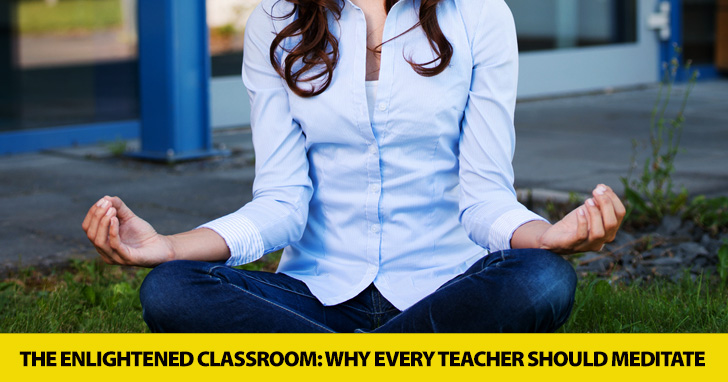Too Tired to Teach? 7 Tips to Detox, De-stress and Regain Your Energy


For some people, meditation remains an untested ‘relaxation method’, but a growing number of people - self included - are convinced that a regular meditation practice can add very meaningfully to many parts of our lives. I’d like to share my own experience, and some hints for beginners, with a particular focus on the importance of meditation for teaching professionals.
Teachers face a remarkable range of stresses, which arrive simultaneously and from different directions.
I’ve always felt that we need as much help as we can get, particularly at a time when teaching doesn’t pay what it should, and has lost a significant measure of the social cache it once had. These aren’t reasons to despair - and I hope you don’t! - but they certainly are reasons to consider adding to your armory of stress-reduction aids.All in the same week, we might find ourselves addressing behavioral issues in our classroom, fighting a budget battle with our department, struggling to catch up with paperwork and grading, arguing with union representatives or officialdom, and dealing with our own, often very complex family lives.
Most new hobbies or self-help practices involve an unwelcome first step: shopping. Happily, meditation requires no equipment or training, is open to absolutely anyone, regardless of gender, age or background, and doesn’t require an annual membership fee. What’s more, it requires no commitment to a particular ‘faith’ or dogma - there is no ‘belief’, and certainly no deity to reckon with - and it can be undertaken as much or as little as is practicable, either alone or in a group.

The first step is perhaps the hardest for many of us, especially those with families: find a quiet place. It doesn’t have to be hermetically silent, but the less noise (especially, I’ve found, repeating noise like a car alarm or a dog barking) around you, the better you’ll be able to focus.
The next challenge can be equally tough: set aside some time. I recommend beginning with just 5-10 minutes of meditation, and increasing this to 15-25 minutes after a few weeks. Tell your family or housemates what you’re doing - there’s nothing weird or shameful about practicing an ancient tradition with solely positive effects - and ask them to respect your privacy and peace.
Place cushions on the floor so that you’ll be able to sit on them for the whole session without becoming unduly uncomfortable. There are a range of meditation cushions available, but before buying anything, work with what you already have at home. Everyone is different, and after a little experimentation, your body will tell you the right height and type of material.
The best posture is with your legs comfortably crossed, your back straight and your head level, as if you’re looking right ahead of you. Imagine that your spine is a stack of coins; try to keep the stack straight. Don’t lean forward too much, as this will hurt your lower back; conversely, leaning back will tax your abdominal muscles. Flex your shoulders and back until you feel as though the back of your skull, the space between your shoulders, and the bottom of your spine are describing a straight line. It will feel as though you’re sitting up very straight; this helps alertness and enhances every aspect of meditation. Each time your posture slips, bring it back to an alert straightness.
Set a timer for the number of minutes you’d like to sit. I recommend the Iphone application, Insight Meditation Timer. It’s free and excellent.
Traditions differ, but I recommend both inhaling and exhaling through the nose. This creates a single focal point and aids the main aim of meditation: the practice of keeping your awareness on a single thing. As you breathe in, notice every sensation - the coolness of the air, the feel of it passing into your nostrils, the natural swell of your chest and stomach - but just notice, don’t fixate. As you exhale, again simply notice the relaxation of your muscles, the sound of the air movement. Follow the air with your attention as it leaves your nose. Then let it go and begin the next breath.
You’ll probably find that this works best with your eyes closed.
From this extraordinarily simple process comes a wealth of benefits. Focusing on a single object - the breath - provides dividends almost immediately. The mind rewards you with a sense of clarity and calm. Other thoughts - objects other than the breath - will pop up and compete for your attention. These are often negative thoughts - worries about the future, regrets about the past - but you’re only here to consider the qualities of the given moment. Allow all other thoughts to pass overhead like a cloud, disappearing into irrelevance. Whenever you lose focus on the breath, notice that this has happened and gently return your attention to it. Even experienced meditators have to bring their focus back dozens of times in each sitting, so don’t feel bad.
Since beginning my meditation practice a few years ago, I’ve become a more relaxed person, less quick to anger and judgment, more understanding, forgiving and empathic, and certainly a better husband and teacher. The experience of calmly focusing on my breathing has given me new patience and tolerance, and a willingness to listen to others rather than selfishly take over the conversation. I’m more able to take the rough with the smooth and to simply shrug my shoulders at the vagaries of life.
I can’t recommend meditation highly enough, for everyone and anyone, but particularly for teachers; our emotional systems are daily taxed, and our capacity for tolerance and acceptance is a key measure of how much we’ll enjoy our professional lives.
Give it a try and let me know how you get on; you’ll be joining a large and growing global community, and helping to heal both yourself and others.